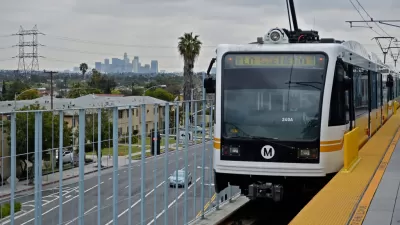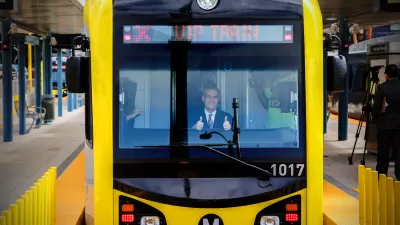Expansion of Los Angeles' light rail system is moving ahead, as a new leg heads west. Though funding is secure, controversy still surrounds the route and its design.
"The University of Southern California's station is nearly complete in Exposition Park. Pylons for an overpass are rising on either side of La Brea Avenue, tracks are welded in Culver City, and the line's undulating sun-shield canopies should start shimmering above stations starting in May. Although beleaguered by community groups seeking changes, the Expo Line remains on track.
The $2-billion-plus project, which is managed by the Exposition Construction Authority (a state agency only partially funded by LA's transit authority), was given a boost by Measure R. The half-cent county sales tax passed by voters last fall will provide needed funds during Phase II-expansion to Santa Monica-and has lent an overall sense of confidence to the project."
"...Not everyone is happy. As development spikes along the route, grassroots groups like Citizens' Campaign to Fix the Expo Rail Line and Neighbors For Smart Rail have mobilized, specifically to prevent at-grade crossings in neighborhoods, which they believe will increase accidents, traffic, noise, and glare. The groups have also claimed that residents in lower-income neighborhoods are not receiving the same safety measures as wealthier Westside residents.
The Citizens' Campaign focused their efforts on the Exposition Boulevard-Farmdale Avenue crossing, which was deemed too close to Dorsey High School, whose students would have to cross the at-grade alignment. After a February ruling that deemed the crossing unsafe, Expo began work on a new proposal to include a pedestrian bridge and a likely permanent closing of Farmdale. An Environmental Impact Review will be available for public comment this summer, and major changes could delay the opening for a year."
FULL STORY: Crossing the Line

Manufactured Crisis: Losing the Nation’s Largest Source of Unsubsidized Affordable Housing
Manufactured housing communities have long been an affordable housing option for millions of people living in the U.S., but that affordability is disappearing rapidly. How did we get here?

Americans May Be Stuck — But Why?
Americans are moving a lot less than they once did, and that is a problem. While Yoni Applebaum, in his highly-publicized article Stuck, gets the reasons badly wrong, it's still important to ask: why are we moving so much less than before?

Research Shows More Roads = More Driving
A national study shows, once again, that increasing road supply induces additional vehicle travel, particularly over the long run.

Judge Halts Enforcement of Anti-Homeless Laws in Grants Pass
The Oregon city will be barred from enforcing two ordinances that prosecute unhoused residents until it increases capacity and accessibility at designated camping sites.

Advancing Sustainability in Los Angeles County Schools
The Los Angeles County Office of Education’s Green Schools Symposium brings together educators, students, and experts to advance sustainability in schools through innovative design, climate resilience strategies, and collaborative learning.

Using Old Oil and Gas Wells for Green Energy Storage
Penn State researchers have found that repurposing abandoned oil and gas wells for geothermal-assisted compressed-air energy storage can boost efficiency, reduce environmental risks, and support clean energy and job transitions.
Urban Design for Planners 1: Software Tools
This six-course series explores essential urban design concepts using open source software and equips planners with the tools they need to participate fully in the urban design process.
Planning for Universal Design
Learn the tools for implementing Universal Design in planning regulations.
City of Moreno Valley
Institute for Housing and Urban Development Studies (IHS)
City of Grandview
Harvard GSD Executive Education
NYU Wagner Graduate School of Public Service
City of Cambridge, Maryland
Newport County Development Council: Connect Greater Newport





























